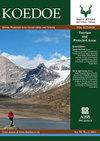南非克鲁格国家公园香肠树(Kigelia africana)生殖生物学
IF 1.1
4区 环境科学与生态学
Q3 BIODIVERSITY CONSERVATION
引用次数: 9
摘要
非洲木兰花的花很大,是脊椎动物授粉的,果实很大,很可能是脊椎动物分散的。我们在克鲁格国家公园(KNP)南部对非洲K. africana的大小级分布进行了实地调查,结果表明缺乏招募。这可能是由于与脊椎动物传播者和/或传粉者的互惠关系失败的结果。育种系统试验表明,非洲支原体是专性异交。尽管主要适应蝙蝠授粉,但在KNP,非洲k.a目前主要由多种主要是兼性食蜜鸟物种授粉。坐果率高,但距离大于50米的果树种子产量较低。我们对扩散的初步调查表明,水果在很大程度上被忽视了,因此对潜在的扩散者的吸引力很弱。与对照区17.5%的死亡率相比,在KNP区田间放置的幼苗死亡率较高(> 50%)。这三倍的差异是在两个月的时间里食草的结果。综上所述,以成虫为中心的种群结构可能不是由于花粉或种子的限制,而是由于扩散限制或过度草食造成的。本文章由计算机程序翻译,如有差异,请以英文原文为准。
Reproductive biology of the sausage tree (Kigelia africana) in Kruger National Park, South Africa
Kigelia africana has large flowers that are vertebrate pollinated and very large fruits that are likely to be vertebrate dispersed. Our field surveys of size–class distributions of K. africana in the southern Kruger National Park (KNP) suggest a lack of recruitment. This is possibly the result of a failure of mutualistic relationships with vertebrate dispersers and/or pollinators. Breeding system experiments indicated that K. africana is an obligate out-crosser. Despite being primarily adapted for bat pollination, in KNP that K. africana is presently mainly pollinated by a diversity of largely facultatively nectarivorous bird species. Fruit-set is high, although trees isolated by > 50 m were found to suffer depressed seed output. Our preliminary investigation of dispersal suggests that fruits are largely ignored and are thus weakly attractive to potential dispersers. Seedlings placed out in the field in KNP suffered high levels (> 50%) of mortality compared to 17.5% in control plots. This threefold difference is the result of herbivory over a 2-month period. In summary, the adult centric population structure is probably not because of pollen or seed limitation but may result from dispersal limitation or excessive herbivory.
求助全文
通过发布文献求助,成功后即可免费获取论文全文。
去求助
来源期刊

Koedoe
BIODIVERSITY CONSERVATION-
CiteScore
3.30
自引率
0.00%
发文量
10
审稿时长
20 weeks
期刊介绍:
Koedoe, with the subtitle ''African Protected Area Conservation and Science'', promotes and contributes to the scientific (biological) and environmental (ecological and biodiversity) conservation practices of Africa by defining the key disciplines that will ensure the existence of a wide variety of plant and animal species in their natural environments (biological diversity) in Africa.
 求助内容:
求助内容: 应助结果提醒方式:
应助结果提醒方式:


